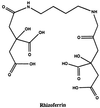Acquisition, transport, and storage of iron by pathogenic fungi
- PMID: 10398672
- PMCID: PMC100245
- DOI: 10.1128/CMR.12.3.394
Acquisition, transport, and storage of iron by pathogenic fungi
Abstract
Iron is required by most living systems. A great variety of means of acquisition, avenues of uptake, and methods of storage are used by pathogenic fungi to ensure a supply of the essential metal. Solubilization of insoluble iron polymers is the first step in iron assimilation. The two methods most commonly used by microorganisms for solubilization of iron are reduction and chelation. Reduction of ferric iron to ferrous iron by enzymatic or nonenzymatic means is a common mechanism among pathogenic yeasts. Under conditions of iron starvation, many fungi synthesize iron chelators known as siderophores. Two classes of compounds that function in iron gathering are commonly observed: hydroxamates and polycarboxylates. Two major responses to iron stress in fungi are a high-affinity ferric iron reductase and siderophore synthesis. Regulation of these two mechanisms at the molecular level has received attention. Uptake of siderophores is a diverse process, which varies among the different classes of compounds. Since free iron is toxic, it must be stored for further metabolic use. Polyphosphates, ferritins, and siderophores themselves have been described as storage molecules. The iron-gathering mechanisms used by a pathogen in an infected host are largely unknown and can only be posited on the basis of in vitro studies at present.
Figures
Similar articles
-
Iron gathering by zoopathogenic fungi.FEMS Immunol Med Microbiol. 2004 Mar 8;40(2):95-100. doi: 10.1016/S0928-8244(03)00301-8. FEMS Immunol Med Microbiol. 2004. PMID: 15040387 Review.
-
Siderophore Biosynthesis and Transport Systems in Model and Pathogenic Fungi.J Microbiol Biotechnol. 2024 Aug 28;34(8):1551-1562. doi: 10.4014/jmb.2405.05020. Epub 2024 Jun 13. J Microbiol Biotechnol. 2024. PMID: 38881181 Free PMC article. Review.
-
Siderophore uptake by Candida albicans: effect of serum treatment and comparison with Saccharomyces cerevisiae.Yeast. 2002 Mar 15;19(4):329-40. doi: 10.1002/yea.840. Yeast. 2002. PMID: 11870856
-
Iron uptake by fungi: contrasted mechanisms with internal or external reduction.Adv Microb Physiol. 2000;43:39-74. doi: 10.1016/s0065-2911(00)43002-x. Adv Microb Physiol. 2000. PMID: 10907554 Review.
-
Iron gathering of opportunistic pathogenic fungi. A mini review.Acta Microbiol Immunol Hung. 2005;52(2):185-97. doi: 10.1556/AMicr.52.2005.2.4. Acta Microbiol Immunol Hung. 2005. PMID: 16003938 Review.
Cited by
-
Siderophore biosynthesis but not reductive iron assimilation is essential for Aspergillus fumigatus virulence.J Exp Med. 2004 Nov 1;200(9):1213-9. doi: 10.1084/jem.20041242. Epub 2004 Oct 25. J Exp Med. 2004. PMID: 15504822 Free PMC article.
-
Unexpected link between iron and drug resistance of Candida spp.: iron depletion enhances membrane fluidity and drug diffusion, leading to drug-susceptible cells.Antimicrob Agents Chemother. 2006 Nov;50(11):3597-606. doi: 10.1128/AAC.00653-06. Epub 2006 Sep 5. Antimicrob Agents Chemother. 2006. PMID: 16954314 Free PMC article.
-
The Exploration of the Antibacterial Mechanism of FE(3+) against Bacteria.Braz J Microbiol. 2011 Jan;42(1):410-4. doi: 10.1590/S1517-83822011000100050. Braz J Microbiol. 2011. PMID: 24031647 Free PMC article.
-
Sensing the heat and the host: Virulence determinants of Histoplasma capsulatum.Virulence. 2019 Dec;10(1):793-800. doi: 10.1080/21505594.2019.1663596. Virulence. 2019. PMID: 31560240 Free PMC article. Review.
-
DectiSomes: C-type lectin receptor-targeted liposomes as pan-antifungal drugs.Adv Drug Deliv Rev. 2023 May;196:114776. doi: 10.1016/j.addr.2023.114776. Epub 2023 Mar 17. Adv Drug Deliv Rev. 2023. PMID: 36934519 Free PMC article. Review.
References
-
- Adjimani J P, Owusu E. Nonenzymatic NADH/FMN-dependent reduction of ferric siderophores. J Inorg Biochem. 1997;66:247–252.
-
- Ardon O, Weizman H, Libman J, Shanzer A, Chen Y, Hadar Y. Iron uptake in Ustilago maydis: studies with fluorescent ferrichrome analogues. Microbiology. 1997;143:3625–3631. - PubMed
Publication types
MeSH terms
Substances
Grants and funding
LinkOut - more resources
Full Text Sources
Other Literature Sources
Medical



